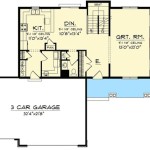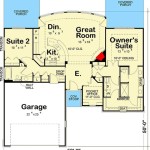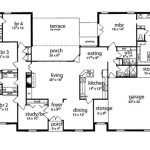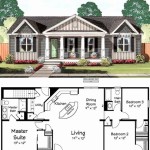An open floor plan house is a residential design where multiple rooms, such as the living room, dining room, and kitchen, are combined into one large, open space. This layout allows for greater freedom of movement, natural light distribution, and a sense of spaciousness. Open floor plans have become increasingly popular in recent years, as they provide a contemporary and functional living environment.
For example, a modern open floor plan house may feature a living room area with comfortable seating facing a large window, which seamlessly transitions into a dining area with an elegant dining table and chairs. The kitchen, equipped with a spacious island and state-of-the-art appliances, flows naturally from the dining area, creating a cohesive and inviting space for entertaining and family gatherings.
In this article, we will delve deeper into the benefits, challenges, and design considerations associated with open floor plan houses. We will explore how this architectural concept can enhance the quality of life for residents while also providing practical solutions for modern living.
Open floor plan houses offer numerous advantages, making them a popular choice for modern living. Here are eight key points to consider:
- Spacious and airy
- Improved natural light
- Enhanced flow and connectivity
- Versatile and customizable
- Foster social interaction
- May require intentional design
- Potential for noise and privacy issues
- Heating and cooling challenges
Understanding these points can help homeowners make informed decisions when considering an open floor plan house.
Spacious and airy
Open floor plan houses are renowned for their spacious and airy ambiance. By eliminating walls and partitions between traditional rooms, these designs create a sense of openness and grandeur that is unmatched in conventional layouts.
- Unobstructed sightlines: The absence of walls allows for clear sightlines throughout the main living areas, enhancing the perception of space and creating a more expansive atmosphere.
- Abundant natural light: Open floor plans often feature large windows and doors that maximize natural light penetration. This not only reduces the need for artificial lighting but also creates a brighter and more inviting living environment.
- Reduced clutter: The open and airy nature of these designs encourages a minimalist approach to furnishing and decor. With fewer walls to obstruct movement, there is a greater sense of flow and spaciousness, even with modest square footage.
- Improved air circulation: The open layout promotes better air circulation throughout the main living areas, reducing stuffiness and creating a more comfortable indoor climate.
The spaciousness and airiness of open floor plan houses contribute to a more comfortable and enjoyable living experience. Residents can move freely, entertain guests effortlessly, and appreciate the ample natural light that floods the space.
Improved natural light
Maximizing Sunlight Penetration
Open floor plan houses are designed to maximize natural light penetration, creating brighter and more inviting living spaces. By eliminating walls and partitions between traditional rooms, these designs allow sunlight to flow freely throughout the main living areas. Large windows and doors are strategically placed to capture sunlight from multiple angles, reducing the need for artificial lighting during the day.
Unobstructed Sightlines
The absence of walls and partitions not only enhances the sense of spaciousness but also allows for unobstructed sightlines throughout the main living areas. This means that natural light can penetrate deep into the interior of the house, reaching even the darkest corners. As a result, open floor plan houses tend to have a brighter and more evenly lit ambiance compared to traditional layouts.
Reduced Need for Artificial Lighting
The abundance of natural light in open floor plan houses significantly reduces the need for artificial lighting during the day. This can lead to energy savings and a more natural and healthy living environment. Residents can enjoy the benefits of natural sunlight, which has been shown to improve mood, boost productivity, and enhance overall well-being.
Health and Well-being Benefits
Natural light has numerous health and well-being benefits. It helps regulate the body’s natural sleep-wake cycle, improves mood and cognitive function, and strengthens the immune system. By providing ample natural light, open floor plan houses can positively impact the health and well-being of their occupants.
The improved natural light in open floor plan houses not only enhances the aesthetics of the space but also contributes to a healthier and more enjoyable living environment. Residents can bask in the benefits of natural sunlight, reducing their reliance on artificial lighting and creating a more harmonious connection with the outdoors.
Enhanced flow and connectivity
Open floor plan houses are renowned for their enhanced flow and connectivity, creating a seamless and cohesive living environment. By eliminating walls and partitions between traditional rooms, these designs foster a greater sense of openness and interconnectedness, promoting ease of movement, communication, and interaction among occupants.
- Unimpeded movement: Open floor plans allow for unimpeded movement throughout the main living areas. Without the obstruction of walls and doorways, residents can move freely and effortlessly between different zones, creating a more fluid and dynamic living experience.
- Improved communication: The open and interconnected nature of these designs facilitates better communication and interaction among occupants. Family members and guests can easily engage in conversations, share experiences, and participate in activities together, fostering a stronger sense of community and belonging.
- Enhanced socialization: Open floor plan houses are ideal for entertaining and socializing. The seamless flow between different areas allows guests to mingle and move around freely, creating a more convivial and interactive atmosphere.
- Greater accessibility: By removing barriers and creating a more accessible layout, open floor plans are particularly beneficial for individuals with mobility challenges or elderly residents. They can navigate the main living areas more easily and safely, enhancing their independence and quality of life.
The enhanced flow and connectivity in open floor plan houses not only promote a more comfortable and convenient living experience but also foster stronger social bonds and a greater sense of community among occupants.
Versatile and customizable
Adapting to Changing Needs and Preferences
Open floor plan houses offer unparalleled versatility and customization options, allowing homeowners to tailor their living space to their unique needs and preferences. The absence of walls and partitions provides a flexible canvas for creating a living environment that adapts to different stages of life, evolving family dynamics, and changing tastes.
Multi-purpose Spaces
One of the key advantages of open floor plans is the ability to create multi-purpose spaces that can serve various functions. For example, a large open area can be used as a living room, dining room, and home office all in one. This flexibility residents to maximize space utilization and create a living environment that meets their specific requirements.
Reconfigurable Layouts
Open floor plans allow for easy reconfiguration of layouts to accommodate changing needs. As families grow or lifestyles evolve, homeowners can rearrange furniture and re-purpose spaces without the constraints of fixed walls. This flexibility ensures that the living environment remains adaptable and responsive to the occupants’ changing circumstances.
Personalized Design
Open floor plans provide homeowners with the opportunity to create a truly personalized living space that reflects their style and personality. With fewer structural barriers, they can incorporate unique design elements, such as custom built-ins, statement lighting fixtures, and bespoke furniture arrangements, to create a home that is both functional and aesthetically pleasing.
The versatility and customizability of open floor plan houses empower homeowners to create living environments that are tailored to their individual needs, preferences, and aspirations. These designs offer a high degree of flexibility and adaptability, allowing residents to shape their homes into spaces that truly reflect their unique lifestyles and aspirations.
Foster social interaction
Open floor plan houses are renowned for their ability to foster social interaction and create a sense of community among occupants. By eliminating walls and partitions between traditional rooms, these designs promote greater connectivity and encourage a more interactive and communal living experience.
- Open sightlines and easy movement: The absence of walls and partitions allows for clear sightlines throughout the main living areas, making it easier for occupants to see and interact with each other. The open and fluid layout encourages movement and facilitates casual encounters, fostering a more social and engaging atmosphere.
- Shared spaces for gathering: Open floor plans often feature large, open areas that can accommodate multiple seating arrangements and activity zones. These shared spaces provide a natural gathering point for family members and guests, encouraging them to come together, socialize, and share experiences.
- Reduced isolation: Traditional floor plans with separate rooms can lead to isolation and a lack of interaction among occupants. Open floor plans, on the other hand, promote a sense of togetherness and belonging. Even when engaged in different activities, occupants remain connected and can easily engage in conversations or share moments with others.
- Enhanced communication: The open and interconnected nature of open floor plans facilitates better communication and interaction among occupants. Family members can easily call out to each other, share updates, or engage in spontaneous conversations, strengthening familial bonds and fostering a sense of community.
By fostering social interaction, open floor plan houses create a more vibrant and engaging living environment where occupants feel connected, supported, and part of a close-knit community.
May require intentional design
Balancing Openness and Privacy
Open floor plans prioritize openness and flow, but they also require intentional design to ensure that private spaces remain private. Thoughtful placement of furniture, strategic use of screens or dividers, and careful consideration of sightlines can help create a balance between openness and privacy.
Defining Zones and Areas
While open floor plans are characterized by their spaciousness, it’s important to define different zones and areas within the space to maintain a sense of order and functionality. This can be achieved through the use of rugs, furniture arrangements, and lighting to create distinct areas for living, dining, and cooking, for example.
Controlling Noise and Acoustics
Open floor plans can present challenges in terms of noise control and acoustics. Hard surfaces and open spaces can lead to sound reverberation and noise transfer between different areas. Intentional design strategies, such as the incorporation of sound-absorbing materials, rugs, and textiles, can help mitigate these issues.
Maximizing Natural Light
Open floor plans rely on natural light to create a bright and airy atmosphere. However, it’s important to consider the placement of windows and doors to ensure that natural light is distributed evenly throughout the space. Skylights and strategic window placement can help maximize natural light penetration, reducing the need for artificial lighting.
Intentional design in open floor plan houses requires careful consideration of privacy, functionality, and acoustics. By implementing thoughtful design strategies, homeowners can create a harmonious living environment that combines the benefits of openness with the necessary elements of privacy, comfort, and functionality.
Potential for noise and privacy issues
Noise Transfer and Reverberation
Open floor plans, with their large, open spaces and minimal barriers, can present challenges in terms of noise transfer and reverberation. Sound travels more easily in open spaces, and hard surfaces, such as hardwood floors and large windows, can reflect and amplify sound, creating a noisy environment. This can be particularly problematic in areas where multiple activities are taking place simultaneously, such as cooking in the kitchen while others are watching TV in the living room.
Lack of Privacy
Open floor plans can also compromise privacy, as there is less physical separation between different areas of the home. Conversations, phone calls, and other activities can easily be overheard in adjacent spaces, reducing the sense of privacy for occupants. This can be especially challenging for those who need quiet spaces for work, study, or personal conversations.
Mitigating Noise and Privacy Issues
To mitigate noise and privacy issues in open floor plans, several design strategies can be employed:
- Acoustic Treatments: Incorporating sound-absorbing materials, such as rugs, curtains, and upholstered furniture, can help reduce noise levels and reverberation. Acoustic panels and soundproof insulation can also be installed to further enhance sound control.
- Strategic Furniture Placement: Using furniture to define different zones and areas can help block sound transmission and create a sense of privacy. Bookshelves, sofas, and tall plants can be strategically placed to absorb sound and create visual barriers.
- Designated Quiet Spaces: Creating designated quiet spaces, such as a study or library, can provide occupants with areas where they can retreat for privacy and focus.
- Noise-dampening Flooring: Opting for noise-dampening flooring materials, such as carpets or cork flooring, can help reduce noise transmission between different levels of the home.
Balancing Openness and Privacy
While open floor plans offer numerous advantages, it’s important to carefully consider the potential for noise and privacy issues. By implementing thoughtful design strategies and incorporating sound-absorbing materials and furniture, homeowners can create open floor plan houses that are both spacious and comfortable, while also ensuring a reasonable level of privacy and acoustic comfort.
Open floor plans can be designed to minimize noise and privacy issues, allowing occupants to enjoy the benefits of an open and flowing living space without sacrificing comfort and privacy. A combination of thoughtful design, strategic furniture placement, and acoustic treatments can create a harmonious and functional living environment.
Heating and cooling challenges
Uneven Temperature Distribution
Open floor plans, with their large, open spaces and high ceilings, can present challenges in terms of heating and cooling. Warm air rises, and in an open floor plan, it can accumulate near the ceiling, leaving the lower areas of the room feeling cold. Conversely, in the summer, cool air can settle near the floor, while the upper areas of the room remain warm. This uneven temperature distribution can lead to discomfort for occupants and increased energy consumption.
Lack of Thermal Mass
Traditional homes often have a significant amount of thermal mass in the form of interior walls, which helps to regulate temperature fluctuations. In open floor plans, the reduced amount of interior walls and the increased use of glass can result in a lack of thermal mass. This means that open floor plan houses can heat up and cool down more quickly, making it more difficult to maintain a consistent temperature.
Airflow Obstructions
Open floor plans, while providing a sense of spaciousness and flow, can also hinder airflow. Without walls and doors to direct airflow, warm air can become trapped in certain areas, leading to hot spots. Similarly, cool air may not circulate evenly throughout the space, resulting in cold spots. This can make it challenging to achieve a comfortable temperature throughout the entire open floor plan.
Energy Efficiency Concerns
The heating and cooling challenges associated with open floor plans can impact energy efficiency. Uneven temperature distribution and a lack of thermal mass can lead to increased energy consumption, as heating and cooling systems have to work harder to maintain a comfortable temperature. Additionally, the use of large windows and doors can contribute to heat gain or loss, further affecting energy efficiency
Addressing the heating and cooling challenges in open floor plan houses requires careful design and the implementation of energy-efficient strategies. By incorporating thermal mass, improving airflow, and utilizing smart heating and cooling systems, homeowners can create comfortable and energy-efficient open floor plan living spaces.










Related Posts








